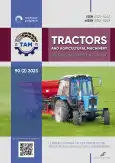Features of furrow formation with rotary and arrow-headed working bodies
- 作者: Benyukh O.A.1, Kravchenko R.I.1
-
隶属关系:
- Kostanay Regional University named after A. Baitursynov
- 期: 卷 90, 编号 2 (2023)
- 页面: 179-186
- 栏目: Economics, organization and technology of nanufacturing
- URL: https://journals.rcsi.science/0321-4443/article/view/132498
- DOI: https://doi.org/10.17816/0321-4443-188660
- ID: 132498
如何引用文章
全文:
详细
BACKGROUND: Soil-cultivating machinery and tools equipped with rotary working bodies are effectively used at operations of surface tillage. However, the subject of furrow formation with rotary working bodies is unaddressed to the full extent that makes it a relevant issue for the study.
AIMS: Revealing the patterns of furrow formation with rotary working bodies equipped with the cutting blades made along the elliptical line at the angle to the working body rotation plane.
METHODS: The grapho-analytical method is presented in the article and used for defining the parameters of a furrow formed with the following types of rotary working bodies: a spherical disk with a closed surface, an annular working body and a rotary working body with the cutting blades made along the elliptical line and set up at the acute angle to the rotation axis. The experiments were carried out in controlled laboratory conditions with a physical model of the rotary working body with the cutting blades made along the elliptical line in a soil channel filled with dampened sand. During the experiments, the attack angle was 20-40° with a step of 10° and the kinematic coefficient, which is the ratio of circumferential velocity to transverse velocity, had the following values: 1, 1.4, 1.8 and 2.2.
RESULTS: The cutting blades made along the elliptical line form short furrows with the ellipse-shaped cross-section and with the angle of inclination from the movement direction of 20-40° depending on the attack angle and the kinematic coefficient. Meanwhile, the furrows formed with the working body have the form of a parallelogram at the top view.
CONCLUSIONS: The practical value of the study lies in revealing the features of furrow formation with rotary working bodies equipped with the cutting blades made along the elliptical line aimed to making a flat bottom of a furrow necessary for grain planting.
作者简介
Oleg Benyukh
Kostanay Regional University named after A. Baitursynov
编辑信件的主要联系方式.
Email: beolan@mail.ru
ORCID iD: 0009-0002-1905-9224
SPIN 代码: 7169-4424
Scopus 作者 ID: 57190964696
Associate Professor, Cand. Sci. (Tech.), Professor of the Machines, Tractors and Automobiles Department
哈萨克斯坦, KostanayRuslan Kravchenko
Kostanay Regional University named after A. Baitursynov
Email: ruslan_kravchenko_15@mail.ru
ORCID iD: 0009-0007-7456-9901
SPIN 代码: 8479-4468
Scopus 作者 ID: 57193999234
PhD, Acting Associate Professor of the Machines, Tractors and Automobiles Department
哈萨克斯坦, Kostanay参考
- GOST 16265-89. Agriculture. Terms and Definitions. Moscow: Izd-vo standartov; 1991. (in Russ.)
- Vozka P. Comparison of alternative tillage systems [MSc Thesis] Silsoe: Cranfield University; 2007.
- Patent KAZ № 7009 / 17.01.2022 Byul. № 15. Benyukh OA. Diskovoe pochvoobrabatyvayushchee orudie.
- Amantayev М, Gaifullin G, Kushnir V, et al. Soil body formation in front of the rotary tillage tools. Biosciences, Biotechnology Research Asia. 2016;13(4):1983–1988.
- Hettiaratchi D. The soil contact zones of concave agricultural disc. Part 1. Theoretical analysis. J. Agric. Engng. Res. 1997:113–125.
- Patent KAZ №3772 / 26.10.2018. Byul. № 40. Gayfullin GZ, Amantaev MA, Kravchenko RI, et al. Rabochiy organ dlya obrabotki pochvy.
- Lezhnev YuV. Obosnovanie parametrov koltsevogo rabochego organa orudiya dlya poverkh-nostnoy obrabotki pochvy [dissertation] Kostanay; 2009.
- Patent KAZ № 6167 / 17.04.2022. Byul. № 8. Benyukh OA. Kultivator-glubokorykhlitel.
- Kushnir VG, Benyukh OA. Improved working body of the cultivator. Tractors and agricultural machinery. 2013;80(3):8–9. (in Russ.) doi: 10.17816/0321-4443-65824
- Gaifullin GZ, Kravchenko RI, Amantaev MA. Improving the quality of tillage with rotary working bodies. Mnogoprofilnyy nauchnyy zhurnal Kostanayskogo gosudarstvennogo universiteta im. A. Baytursynova «3i: intellect, idea, innovation – intellekt, ideya, innovatsiya». 2019;2:44–51.
- Konstantinov MM, Gaifullin GZ, Kushnir VG, et al. Substantiation of regularities of changes in the number of knives of an active rotary working body for tillage. Izvestiya Orenburgskogo gosudarstvennogo universiteta. 2017;5(67):109–112. (in Russ.)
- Amantayev М, Gaifullin G, Kravchenko R, et al. Investigation of the furrow formation by the disc tillage tools. Bulgarian Journal of Agricultural Science. 2018;24(4):704–709.
补充文件














